WestWind T’ai Chi

Tai Chi & Qigong / Chi Kung
November 5, 2015
History
November 10, 2015WestWind T’ai Chi


T’ai Chi Ch’uan (tie chee chuwan) is a form of exercise and a way of living that has been practiced in the Chinese culture for thousands of years. T’ai Chi is a combination of ancient philosophical teaching, a system of health and healing, a form of meditation and a system of self-defense. T’ai Chi helps us create balance in our lives by teaching us to be in Harmony with the Universe. It is more than just physical exercise or mental exercise, but a meshing of the two.
The Chen style of T’ai Chi Ch’uan is known as the Original style from which all other styles of T’ai Chi developed. Chen style T’ai Chi combines fast and slow movements as well as hard and soft to create a balance of opposite, or Yin and Yang energies. This, in turn, creates balance in our minds, bodies and souls. Chen style T’ai Chi promotes health as well as self defense. Indeed, it is a well-rounded martial art from which anyone can benefit.
Traditionally, all Martial Arts styles were practiced as a means of self defense, but also as a way to create “gong fu” or “mastery of” the Self. A person could not very well defend him/herself without being able to master emotions and energy.
Today we practice T’ai Chi to gain mastery of our bodies, minds and souls. This, in turn, helps us be the best we can be it whatever capacity we choose – from being the best we can at our jobs and in our personal lives to increasing our golf swing or ability to balance making dinner and helping kids do homework at the same time.
T’ai Chi is an all-inclusive art. It is gentle and encouraging to those who have had little or no exercise, and is challenging to those who love to work out. T’ai Chi is all about creating balance in our lives and helping us grow into the very best person we can be.
Forms
T’ai Chi is cultivated through practice of Forms, also known as Kata in Japanese. There are several Forms in the Chen family system. Each Form teaches basic moves, or Postures, which are linked together by transition movements. Each Posture has a name which helps in learning the mechanics of the move, but also helps explain the energy being created or used in the move as well – such as White Crane Flashes Its Wings, or Part the Wild Horse’s Mane.
When learning a new form, don’t think about having all the material as soon as possible, but use each Posture as a tool to help you learn more about how you move and work with energy. In general, the Western mind is taught to think that more is better, when what we need is a good understanding of what we are doing with what we have. There are many applications in any Form – self-awareness, awareness of others and Martial application. Learning and understanding the Posture in each Form will help you improve mentally and physically and will develop awareness of your energy and how to apply it.
QiGong
Qi (Chee) is the Chinese term for our internal energy or life essence. All aspects in the body – breath, heartbeat, muscular movement, and mental activity – are attributed to this energy force that keeps us alive and active. GONG (Kung) can be translated as “control” or “mastery by repetition”. Thus, QiGong, in essence, means “control of the breath energy” or “mastering breath energy”.
QiGong exercises are short, simple movements that are repeated or “put on a loop” and practiced for several minutes at a time in order to allow the mind and body to move together as one complete unit. QiGong can be done alone as its own exercise, but is often used in tandem with T’ai Chi practice as it prepares the body and mind before forms practice.
With each exercise, make a practice of always breathing in through the nose and out through the mouth. The tongue may rest on the roof of the mouth.
